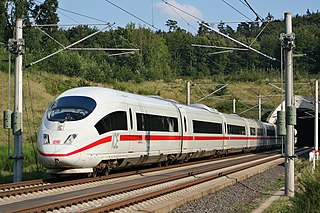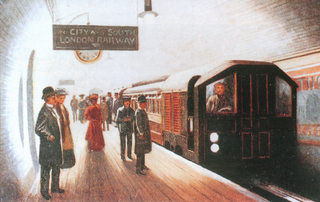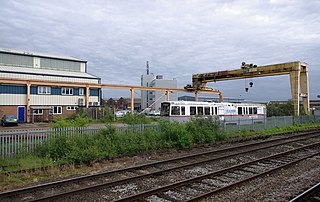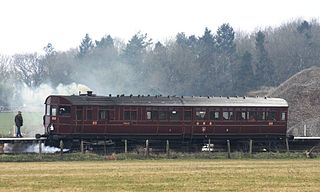
A multiple-unit train or simply multiple unit (MU) is a self-propelled train composed of one or more carriages joined, which when coupled to another multiple unit can be controlled by a single driver, with multiple-unit train control.

The Midland Railway Carriage and Wagon Company was a Birmingham, England, based manufacturer of railway carriages and wagons. It was not part of the Midland Railway.

Metro-Cammell, formally the Metropolitan Cammell Carriage and Wagon Company (MCCW), was an English manufacturer of railway carriages, locomotives and railway wagons, based in Saltley, and subsequently Washwood Heath, in Birmingham. The company was purchased by GEC Alsthom in May 1989; the Washwood Heath factory closed in 2005 and was demolished in early 2019.


The London Underground O and P Stock electric multiple units were used on the London Underground from 1937 to 1981. O Stock trains were built for the Hammersmith & City line, using metadyne control equipment with regenerative braking, but the trains were made up entirely of motor cars and this caused technical problems with the traction supply so trailer cars were added. P Stock cars were built to run together with the O Stock cars now surplus on Metropolitan line Uxbridge services. The trains had air-operated sliding doors under control of the guard; the O Stock with controls in the cab whereas the P Stock controls in the trailing end of the motor cars. The P Stock was introduced with first class accommodation, but this was withdrawn in 1940.

The G series was the first rolling stock of rapid transit cars used on the Toronto subway, built 1953–1959 by the Gloucester Railway Carriage and Wagon Company of Gloucester, England, for the Toronto Transit Commission (TTC) of Toronto, Canada.

London Underground battery-electric locomotives are battery locomotives used for hauling engineers' trains on the London Underground network where they can operate when the electric traction current is switched off. The first two locomotives were built in 1905 for the construction of the Great Northern, Piccadilly and Brompton Railway, and their success prompted the District Railway to buy two more in 1909, which were the only ones built to the loading gauge of the subsurface lines. Following this, a number of battery vehicles were built by converting redundant motor cars, with the batteries placed in the unused passenger compartment. One exception to this was made by the City and South London Railway, who used a trailer car to hold the batteries, and wired them to a separate locomotive.

Stadler Rail is a Swiss manufacturer of railway rolling stock, with an emphasis on regional train multiple units and trams. It is also focused on niche products, such as being one of the last European manufacturers of rack railway rolling stock. Stadler Rail is headquartered in Bussnang, Switzerland.

Cravens Railway Carriage and Wagon Company Limited was a railway rolling stock builder in the Darnall district of Sheffield, England. Founded by brothers named Craven and known as Craven Brothers, later Cravens Limited, it remained a family business until John Brown & Company acquired a controlling shareholding in 1919. Its name was changed back to Cravens Limited in 1954 when it finally became a wholly owned subsidiary of John Brown.

The Central London Railway Stock were electric multiple units composed of trailers that had been converted from carriages designed to be hauled by electric locomotives with new motor cars. The Central London Railway opened in 1900 with electric locomotives hauling wooden carriages, but the heavy locomotives caused vibrations that could be felt in the buildings above the route. It was found that conversion to electric multiple units solved the problem, so new motor cars were bought and replaced all the locomotives by June 1903. Trains normally ran with six-cars, four trailers and two motor-cars. Some trailers were equipped with control equipment to allow trains to be formed with three cars.

Derby Litchurch Lane Works is a railway rolling stock factory in Derby, England. It was opened in the 19th century by the Midland Railway. The plant has produced rolling stock under the ownership of the Midland Railway. It is now owned by Alstom.

The steam rail motors (SRM) were self-propelled carriages operated by the Great Western Railway in England and Wales from 1903 to 1935. They incorporated a steam locomotive within the body of the carriage.

CSR Corporation Limited (CSR), formerly known as China South Locomotive & Rolling Stock Corp was a Chinese manufacturer of locomotive and rolling stock.
The GN & C Stock was operated on the Great Northern and City Railway, an underground railway line in London, England. It was opened between Moorgate and Finsbury Park on 14 February 1904. The original GN&C Stock operated on the line between 1904 and 1939.

Fielding & Platt was a firm of hydraulic engineers who were an important part of the manufacturing sector in Gloucester until the 1990s. Started by two Lancashire men, Samuel Fielding and James Platt, the firm exploited the portable hydraulic rivetting technology of Ralph Hart Tweddell to build a business that exported hydraulic machinery worldwide. Apart from the wide range of items made, the firm was particularly noted for the quality and long-life of their products.
London's Metropolitan Railway (MR) amalgamated with other underground railways, tramway companies and bus operators on 1 July 1933, to form the London Passenger Transport Board (LPTB); the MR became the Board's Metropolitan line.

Metropolitan Railway electric multiple units were used on London's Metropolitan Railway after the lines were electrified in the early 20th century.

The Siemens Inspiro is a family of electric multiple units designed and manufactured by Siemens since 2012 for metro systems. The product was launched on 19 September 2012 at the InnoTrans in Berlin. The first Inspiro entered service with Warsaw Metro on 6 October 2013.



















